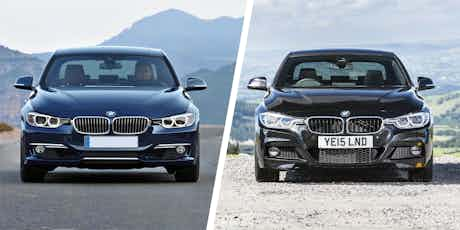BMW 3 Series: old vs new facelift version compared
September 23, 2015 by carwow staff

Throughout most of its 40-year existence, the BMW 3 Series has been considered one of the big cheeses in the compact executive segment of the car market. Testers have consistently heaped praise on its engine lineup, fun driving experience and impressive build quality.
The current sixth generation model (known as F30 in BMW circles) has been with us since 2012. Due to increasing pressure from competitors like the Mercedes C-Class and Jaguar XE, BMW has felt the need to tweak the range for 2015. We compare the updated model to its predecessor, to show what improvements have been made.
Head over to our BMW 3 Series deals page to view the latest carwow offers or use our car chooser tool if you’re not sure what to buy.
Styling

From the outside, it’s very hard to see if anything has changed at all. The 3 Series face has undergone the most minor of surgeries – in fact, it’s barely had a shave. The front grille is widened by mere millimetres, while the LED running lights have been changed. At the rear of the car, LED graphics for the lights have been updated and the tailpipes are larger in diameter than before.
There is good reason for the styling changes (or lack thereof) – BMW buyers have been very fond of the current model, so there was no need to change a popular formula. Combined with the M Sport bodykit and 19-inch alloy wheels, it’s hard to argue that it isn’t handsome.
Interior

As with the exterior updates, changes to the 3 Series cabin are just as minor. A couple of surfaces are now treated to glossy plastics, and the switches for the climate control system have been freshened up.
That’s no bad thing though – the previous 3 Series was well-received for the quality of the cabin, both in terms of the materials used and the way they’re all fixed together. As always, the low and infinitely-adjustable driving position is excellent. No major changes have been introduced to the body or the chassis, so both interior space and the 480-litre boot space remain unchanged.
Driving

Now that the Jaguar XE is on sale, the BMW faces the biggest threat yet to its title of ‘driving enthusiasts’ saloon car.’ Many of the updates to 3 Series aim to nudge it back to the head of the class.
The electric power steering system has been adjusted to give a more precise feel through the steering wheel, and the optional adaptive dampers now have a greater range of adjustment, allowing for a better compromise between comfort and sporty handling.
Critics believe that the BMW engineers have got things pretty much spot on. Very few, if any, rivals handle with the same level of agility, while the ride is described by one tester as feeling “just the right side of firm”. However, the steering changes aren’t to everyone’s tastes. A slight dead spot has been introduced around the straight ahead. It’s meant to make the 3 Series feel more stable at speed, but some testers find it a little irritating.
Overall though, it is more precise than before, so once you grow accustomed to the initial vagueness it’s more pleasant to use.
Engines

The engine lineup has also received plenty of attention in the latest round of updates, in many cases the units offer both more power and superior fuel efficiency than before.
At the entry point of the range sits a 1.5-litre three-cylinder turbocharged petrol. Dubbed the 318i, it replaces the previous 1.6-litre unit found in the 316i. The same 134hp unit is also found in the Mini Cooper, and here it is capable of a 8.9-second 0-62mph sprint. It feels flexible thanks to having 162lb ft of torque, while testers have been impressed by how quiet it sounds from within the cabin.
The most popular 3 Series model in the range, the 320d, is more frugal than ever. Carbon dioxide emissions have dropped from 102g/km to 99g/km (meaning it’s now free to tax), while fuel economy has jumped up 1.9mpg to 74.3mpg, making it a great choice for company car users and private buyers alike.
Sitting below the M3 towards the top of the range is the 340i. Replacing the 335i, the turbocharged 3.0-litre engine produces 321hp and 332lb ft – up 20hp and 37lb ft on its predecessor. Paired with the eigh-speed automatic gearbox, it’ll sprint from 0-62mph in 5.1 seconds.
That automatic gearbox is a gem, too. Although largely similar to the one found in the Jaguar XE, it uses BMW’s own software, which results in smoother and faster shifts. In some cases, it works with the satellite navigation system to pre-select the right gear for any approaching corner
Value for money

As of September 2015, all new BMWs are equipped with satellite navigation as standard, so the latest 3 Series is already off to a great start in the value-for-money stakes. Prices remain almost unchanged from the older version, while the improved fuel efficiency should see daily running costs decrease slightly, too.
As the 3 Series hasn’t significantly changed from the previous car, it will still achieve the maximum five-star Euro NCAP crash test rating.
Save money on your next car
To find out more about the latest 3 Series, our full review offers all the info you’ll ever need, including how it compares to rivals like the Mercedes C-Class, Audi A4 and Jaguar XE. Need a little more space? you can find details about the Touring estate version here or head over to our BMW 3 Series deals page to check out the latest offers.















